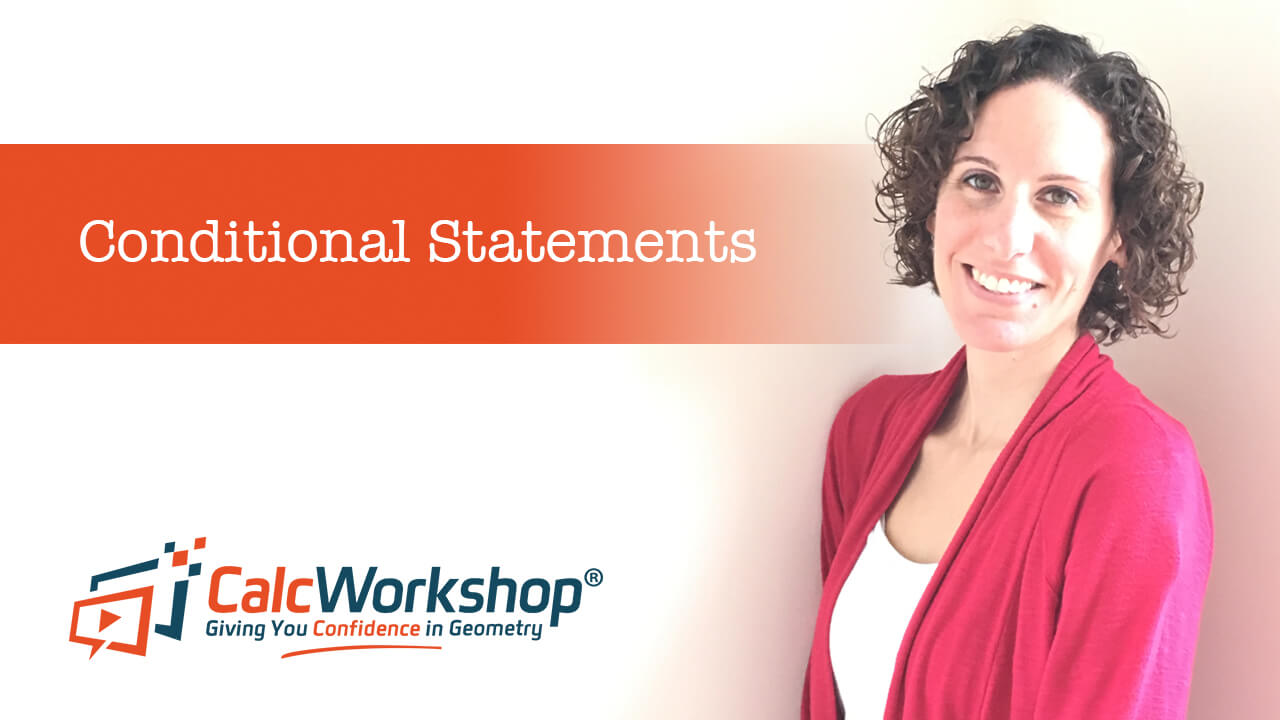In today’s geometry lesson, you’re going to learn all about conditional statements!

Jenn, Founder Calcworkshop®, 15+ Years Experience (Licensed & Certified Teacher)
We’re going to walk through several examples to ensure you know what you’re doing.
In addition, this lesson will prepare you for deductive reasoning and two column proofs later on.
Here we go!
What are Conditional Statements?
To better understand deductive reasoning, we must first learn about conditional statements.
A conditional statement has two parts: hypothesis (if) and conclusion (then).
In fact, conditional statements are nothing more than “If-Then” statements!
Sometimes a picture helps form our hypothesis or conclusion. Therefore, we sometimes use Venn Diagrams to visually represent our findings and aid us in creating conditional statements.
But to verify statements are correct, we take a deeper look at our if-then statements. This is why we form the converse, inverse, and contrapositive of our conditional statements.
What is the Converse of a Statement?
Well, the converse is when we switch or interchange our hypothesis and conclusion.
Example
Conditional Statement: “If today is Wednesday, then yesterday was Tuesday.”
Hypothesis: “If today is Wednesday” so our conclusion must follow “Then yesterday was Tuesday.”
So the converse is found by rearranging the hypothesis and conclusion, as Math Planet accurately states.
Converse: “If yesterday was Tuesday, then today is Wednesday.”
What is the Inverse of a Statement?
Now the inverse of an If-Then statement is found by negating (making negative) both the hypothesis and conclusion of the conditional statement.
Example
So using our current conditional statement, “If today is Wednesday, then yesterday was Tuesday”.
Inverse: “If today is not Wednesday, then yesterday was not Tuesday.”
What is a Contrapositive?
And the contrapositive is formed by interchanging the hypothesis and conclusion and then negating both.
Example
Contrapositive: “If yesterday was not Tuesday, then today is not Wednesday”
What is a Biconditional Statement?
A statement written in “if and only if” form combines a reversible statement and its true converse. In other words the conditional statement and converse are both true.
Example
Continuing with our initial condition, “If today is Wednesday, then yesterday was Tuesday.”
Biconditional: “Today is Wednesday if and only if yesterday was Tuesday.”

Examples of Conditional Statements
In the video below we will look at several harder examples of how to form a proper statement, converse, inverse, and contrapositive. And here’s a big hint…
Whenever you see “con” that means you switch! It’s like being a con-artist!
Moreover, we will detail the process for coming up with reasons for our conclusions using known postulates. We will review the ten postulates that we have learned so far, and add a few more problems dealing with perpendicular lines, planes, and perpendicular bisectors.
After this lesson, we will be ready to tackle deductive reasoning head-on, and feel confident as we march onward toward learning two-column proofs!
Conditional Statements – Lesson & Examples (Video)
1 hr 5 min
- Introduction to conditional statements
- 00:00:25 – What are conditional statements, converses, and biconditional statements? (Examples #1-2)
- 00:05:21 – Understanding venn diagrams (Examples #3-4)
- 00:11:07 – Supply the missing venn diagram and conditional statement for each question (Examples #5-8)
- Exclusive Content for Member’s Only
- 00:17:48 – Write the statement and converse then determine if they are reversible (Examples #9-12)
- 00:29:17 – Understanding the inverse, contrapositive, and symbol notation
- 00:35:33 – Write the statement, converse, inverse, contrapositive, and biconditional statements for each question (Examples #13-14)
- 00:45:40 – Using geometry postulates to verify statements (Example #15)
- 00:53:23 – What are perpendicular lines, perpendicular planes and the perpendicular bisector?
- 00:56:26 – Using the figure, determine if the statement is true or false (Example #16)
- Practice Problems with Step-by-Step Solutions
- Chapter Tests with Video Solutions
Get access to all the courses and over 450 HD videos with your subscription
Monthly and Yearly Plans Available
Still wondering if CalcWorkshop is right for you?
Take a Tour and find out how a membership can take the struggle out of learning math.